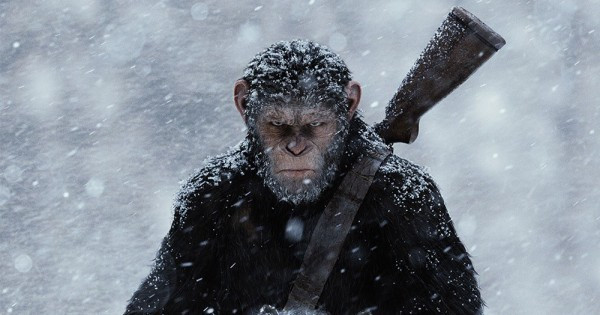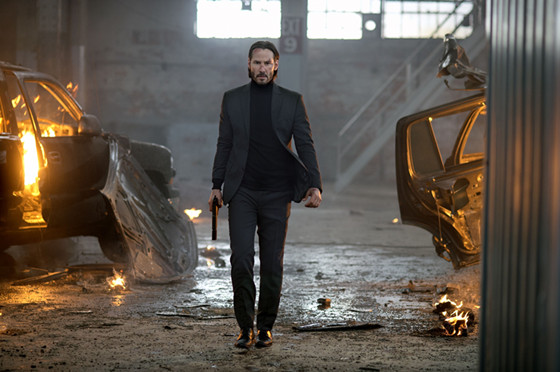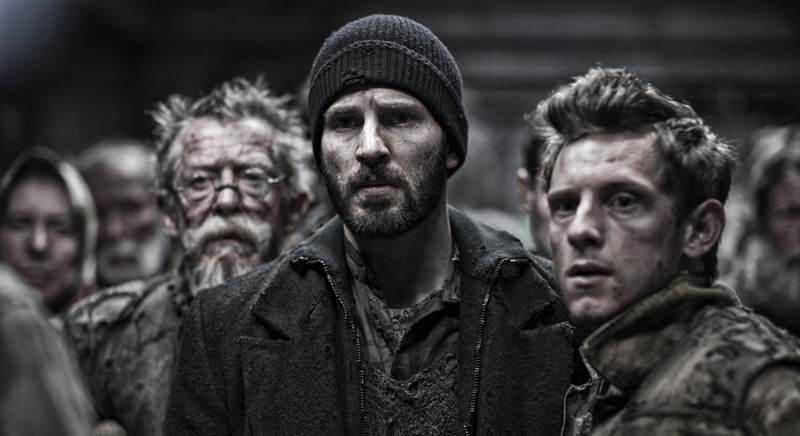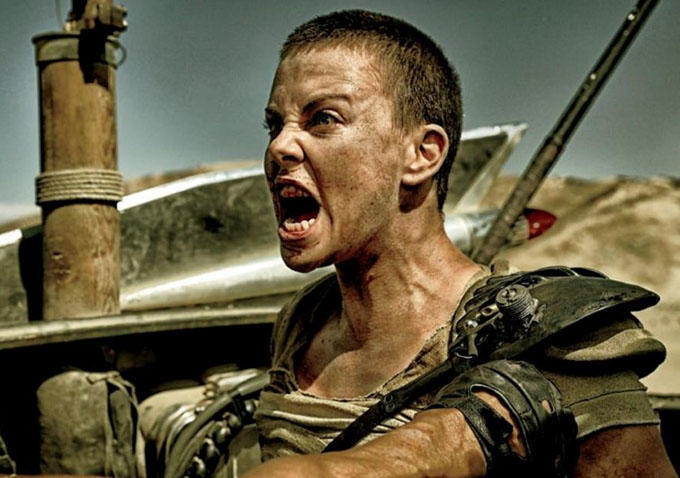5. War for the Planet of the Apes

Apes sling military-grade assault rifles across their backs, and set to dismantle an encampment of megalomaniacs hellbent on destroying civilization. Meanwhile, a virus stretches its poisonous tendrils across the globe with the mission to wipe out the dwindling remnants of the human race. This time, for good. For sure, that summary describes the ideal action movie recipe, i.e. the promise of a shoot-em-up thrill ride packaged alongside a dash of glib silliness. But while bullets blaze in War for the Planet of the Apes, the once essential kitsch factor remains far away. The film chronicles the final showdown between people and primates, but the story hinges on serious questions about how our behavior impacts the future.
In their ongoing quest to recycle profitable formulas, Hollywood keeps doling out various sequels, prequels, remakes, reboots, and cross-pollinations of the four. The Planet of the Apes franchise marks no exception, but the trilogy that rolled out during the 2010s delivers the most emotional, thrilling, and intelligent storytelling of the lot. The third and (thus far) latest installment comes chock full of surprises, catharses, and gorgeously choreographed action. And it pulls a masterful story arc off without a shred of exposition or talking down to the audience. Plus, if that final moment fails to move you, check your pulse.
4. John Wick

Revenge sagas give us a whole other action subgenre to explore, a category with its own unique tropes and complexities. Though these films have persisted for a couple of generations, talented storytellers continue showing the cat-and-mouse schtick from new and refreshing angles. In the 2000s, audiences received Old Boy, Irréversible, and the two volumes of Kill Bill, all of which breathed new life into an existing formula. But in this soon-to-end decade, cinephiles gravitated toward the John Wick trilogy, which provided more texture, nuance, and depth to the revenge movie blueprint. In exploring the motivation that prompts someone to respond to violence with more violence, director Chad Stahelski manages to untangle the psychology behind our natural thirst for comeuppance.
In short, our retired hitman hero seeks retribution against the putrid gang who murdered his dog. If a filmmaker aims to give an audience a relatable motivation, the bond we share with our canine comrades opens the perfect pathway. The slaughter of one of our four-legged friends gives enough incentive to rampage against those responsible, especially true if that particular dog installed hope in a time of crushing grief. What begins as an operatic plot evolves into a kaleidoscope series of blood and bullets and broken bones. But at the center of the story stands the film’s most compelling element, the setting.
Much of the action unfolds inside a neutral territory hotel, a high rise wherein contract killers and other baddies share drinks and order room service, and though trigger-happy assassins populate the building, the rules state that no blood shall spill on the premises. This angle adds the perfect caveat that enriches an otherwise stripped-back story.
3. Snowpiercer

A group of characters must move from point A to point B, much of the time within an enclosed space, without meeting their demise. How many action films center on this simple narrative device? No doubt that a huge chunk of these movies use this familiar story framing. In fact, 50 percent on the motion pictures on this list fit that description, but none pull it off with more nail-biting exhilaration and socially relevant intelligence than Bong Joon Ho’s Snowpiercer.
Starting at the tailend of a train, the protagonists hack, slash, and outwit their way through boxcars populated with enemies and obstacles, and in the final moments, less than a handful of them reach the treasure at the front. That treasure remains quite literal—the journey happens in light of extreme wealth inequity where those in the caboose feed off black, gelatinous protein slabs while the wealthy and powerful enjoy gourmet food and use child labor to keep the train engines in shape. It bears mentioning as well that the few people aboard represent the only surviving members of the human species—before the film takes place, climate change rendered Earth unlivable. Any of this sound relevant?
2. Mandy

Begin with a hyper-manic Nicolas Cage performance that keeps breaking thresholds of intensity. Blend in a little face-melting phantasmagoria from the imagination of director Panos Cosmatos. Add a pinch of pitch-black humor. With that recipe, you get Mandy, a two-hour cross between a lucid fever dream and a terrifying acid trip. At least we remain safe watching the wackiness unfold from a third-party point of view.
Otherwise, the burning bodies, cocaine snorted from a glass shard plate, and chainsaw sword fights might cause distress. And let it be known that not a moment of this blood-and-gasoline-soaked brouhaha happens as a hallucination or projection of anxiety (save the scenes that happen when characters take LSD.) All of it remains not only real, but also believable, even when our reluctant hero reshapes melted metal to forge a sword fit for serious demon slaying.
Some may disagree with Mandy falling under the action movie umbrella. Fair enough—the film includes arthouse sensibilities on par with Terrence Malick’s loftiest work (the fragility of love and domesticity) and Luis Buñuel’s most experimental imagery (a gluttonous, impish creature christened the Cheddar Goblin). Even though it pays homage to the movies that play only in museums and independent theaters, Cosmatos stays far away from the highfalutin art film aura that keeps many moviegoers buying tickets only to the latest superhero schlock. Instead the director continues injecting the audience with high-octane adrenaline jolts that keep us locked in thrill mode throughout the runtime.
1. Mad Max: Fury Road

Blockbusters catch a ton of flack, and perhaps that happens for justifiable reasons. With the Disney assembly line pumping out templated content at a breakneck pace, it makes sense that most critics prefer smaller projects that focus on the human condition stuff. Lucky for them that Mad Max: Fury Road bridges the gap between explosion-centric thrill rides and thoughtful cinematic meditations. The film works as a perfect balance with big budget stunts framed via ars gratia artis photography, exhilarating audiences while it enlightens them.
This picture, the decade’s best, shows us a planet that stands inches from irrevocable collapse, a toxic landscape where the sands shift and stretch toward the horizon. This barren route becomes Fury Road, a path on which our heroes attempt to usher out a group of slave-wives forced to act as baby incubators on a sadistic tyrant’s behalf. With human beings treated as livestock and vital resources withheld from the impoverished masses, the fourth Mad Max installment paints the portrait of a world coated in the muck of greed and cruelty. That it debuted smack in the middle of this decade, long enough for many movies to become erased from memory, fails to erase its ongoing resonance.
Director George Miller’s exploration of aesthetic judgment creates the key factor in the film’s perseverance. From the first frame to the final shot, he shows us grotesque situations and character design that shine with simultaneous doses of beauty and revulsion. In light of this fearful symmetry, alongside many other factors, it keeps its position as the finest action film of the 2010s.
Author Bio: John Stanford Owen received his MFA from Southern Illinois University, where he also taught English courses. When not penning reviews and essays on cinema, JSO reads and writes poetry, takes walks with his wife and dog, and dances to Radiohead. Connect with him on Twitter @jstanfordowen.